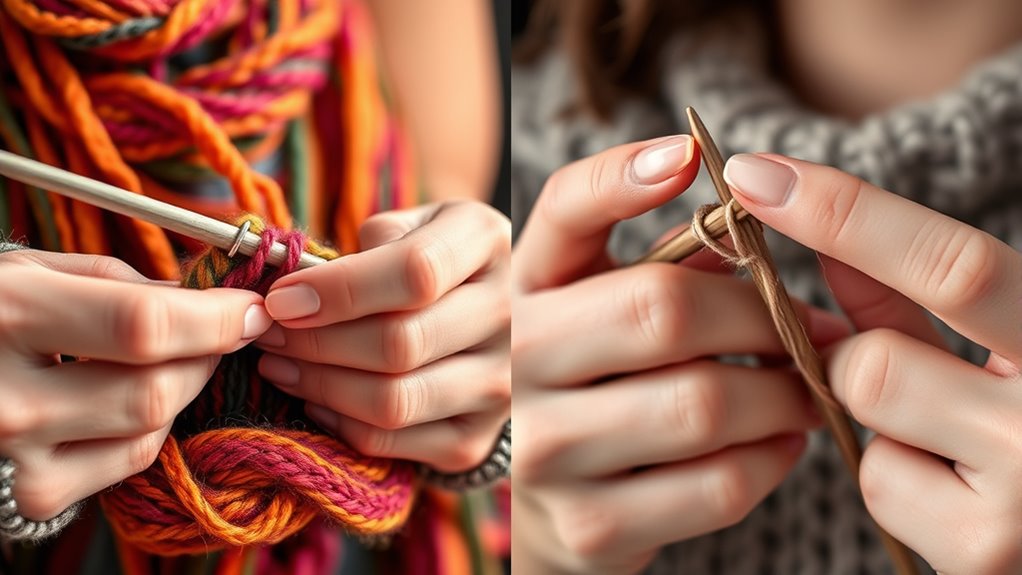In the debate between Continental and English knitting, your holding method influences tension, speed, and stitch quality. With Continental, you hold yarn in your left hand for steady tension and smoother, more consistent stitches, ideal for complex patterns. English involves holding yarn in your right hand, which can be faster once mastered but may produce uneven tension. Keep exploring these techniques to discover the style that suits your projects and enhances your knitting skills.
Key Takeaways
- Continental knitting holds yarn in the left hand for consistent tension, ideal for complex patterns.
- English knitting uses the right hand with a tossing motion, often faster with practice.
- Continental offers smoother rhythm and better tension control, suitable for detailed or tight stitches.
- English may be slower initially but can become quicker, focusing on speed and rapid projects.
- Regular practice improves tension, speed, and creates even, professional-looking stitches in both styles.

When learning to knit, understanding the different styles can make a big difference in your experience and results. Two popular methods are Continental and English knitting, each with unique techniques that influence your yarn tension and knitting speed. Choosing the right style depends on your comfort and the kind of projects you want to tackle.
Understanding Continental and English knitting helps you choose the best style for comfort and project goals.
In Continental knitting, you hold the yarn in your left hand, which allows for a more efficient and consistent yarn tension. Because the yarn is already in your hand, you can quickly slide it into position without adjusting your grip much, leading to a smoother, more rhythmic motion. This can help you develop a steady knitting speed once you get the hang of it. Many find that Continental knitting offers better control over yarn tension, especially when working on complex patterns or tight stitches. The motion feels more natural for some, enabling you to keep a consistent yarn tension without much effort. As a result, your stitches tend to be even, and your overall tension remains stable, which is *essential* for achieving a professional look.
On the other hand, English knitting involves holding the yarn in your right hand, often wrapped around your fingers in a way that resembles tossing or throwing the yarn over the needle. This style can initially feel slower because of the extra movement involved in wrapping the yarn around your fingers each time you make a stitch. However, it can also be faster once you’ve built up the rhythm, especially if you’re used to the motion of throwing the yarn. The key advantage with English knitting is that it allows for quick, dynamic movement, which can boost your knitting speed over time. That said, maintaining consistent yarn tension may require more focus, as the motion can sometimes cause uneven tension if your hand isn’t steady. Variations in yarn tension can lead to uneven stitches, which might affect the appearance of your project.
Ultimately, your choice between Continental and English knitting comes down to comfort and your personal goals. If you want a style that promotes steady yarn tension and consistent stitch quality, Continental might suit you best. If you prefer a more dynamic approach that can increase your knitting speed and adapt to fast-paced projects, then English knitting could be the way to go. Additionally, some knitters find that different yarn weights may perform better with one style over the other, depending on the project. Whichever style you choose, practicing regularly will help you refine your technique, improve your yarn tension control, and boost your knitting speed. Over time, you’ll develop a rhythm that feels natural and produces beautiful, even stitches, making your knitting experience more enjoyable and rewarding.
Frequently Asked Questions
Which Knitting Style Is Better for Beginners?
You’ll find that Continental knitting is better for beginners because it offers ergonomic benefits, making it easier on your hands and wrists. Its faster, more efficient technique helps you develop a steady rhythm. While the aesthetic differences are subtle, Continental knitting produces a slightly tighter, more uniform fabric. Overall, starting with this style can boost your confidence and comfort, making your knitting experience more enjoyable and sustainable as you learn.
How Do I Switch Between Styles Mid-Project?
Did you know that changing styles mid-project can improve your technique consistency? To do this, you should practice each style separately to build muscle memory, then gradually incorporate the new technique. When shifting, focus on maintaining even tension and stitch count. Take your time, and don’t rush the style transition. With patience, you’ll master switching seamlessly, making your knitting more versatile and enjoyable.
Can I Combine Continental and English Techniques?
Yes, you can combine continental and English techniques for style blending, but it depends on your technique compatibility. To do this successfully, practice switching between styles carefully to maintain even tension. Keep in mind, blending may take some getting used to, so work slowly at first. Ultimately, experimenting allows you to create unique textures and effects, making your knitting more versatile and personalized.
Which Style Produces a More Stretchy Fabric?
You’ll find that English knitting generally produces a more stretchy fabric compared to the continental style. This is because the English method tends to create looser tension, enhancing fabric elasticity, while the continental style offers tighter, more controlled stitches. If you want a stretchier fabric for projects like socks or ribbing, you’ll likely prefer the English technique for its superior stretchiness comparison.
Are There Specific Yarn Types Suited for Each Style?
Think of yarn textures like a painter’s brush, each suited for different strokes. For Continental knitting, smooth, fine yarns work best, especially with colorwork techniques, allowing for crisp, neat patterns. English knitting often pairs well with thicker, textured yarns that add durability. Choosing the right yarn type enhances your style, making your stitches sing—whether you want delicate elegance or bold texture.
Conclusion
So, now you’re armed with the epic showdown: Continental vs. English knitting. Whether you prefer the lightning-fast, no-nonsense continental or the traditional, charm-rich English style, the choice is yours—and clearly, your knitting skills are about to become legendary. Just don’t blame us if your friends start calling you “The Knitting Conqueror.” Whichever style you pick, one thing’s certain: you’re destined to create cozy masterpieces—and maybe even out-knit your grandma someday. Happy knitting!








